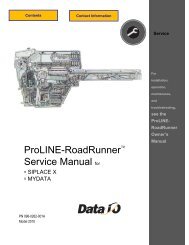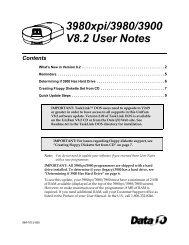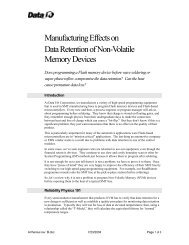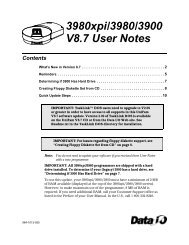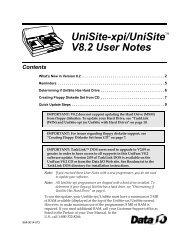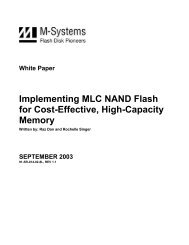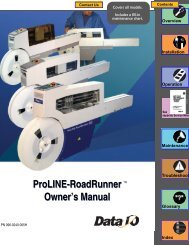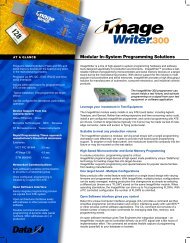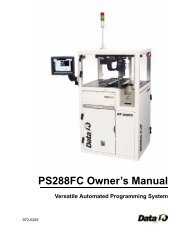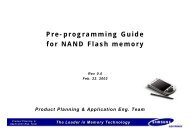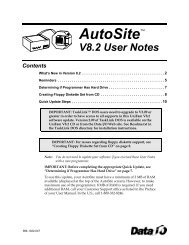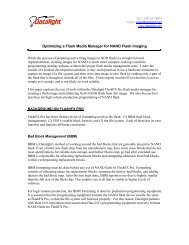3980xpi Users Manual - Data I/O Corporation
3980xpi Users Manual - Data I/O Corporation
3980xpi Users Manual - Data I/O Corporation
You also want an ePaper? Increase the reach of your titles
YUMPU automatically turns print PDFs into web optimized ePapers that Google loves.
Messages<br />
Probable Cause Solution<br />
Additional Information<br />
An illegal bit error indicates that at least one location in the device contains data<br />
(programmed state) while its corresponding location in RAM has no data<br />
(unprogrammed state). For example, the unprogrammed state of a PROM is 0,<br />
while its programmed state is 1.<br />
If a particular 8-bit PROM's memory location contains 09 hex (00001001 binary),<br />
and the corresponding memory location in RAM contains F0 hex (11110000<br />
binary), then an illegal bit error occurs because the programmer is not able to<br />
unprogram the first and fourth least significant bits.<br />
I/O Timeout Error<br />
Probable Cause Solution<br />
Wrong download<br />
command sent to host<br />
Wrong I/O translation<br />
format code selected<br />
Unrecognized characters<br />
in beginning of file<br />
No recognizable end-offile<br />
character or record in<br />
file<br />
Additional Information<br />
Workaround: On your programmer's Device List, find the earliest<br />
version of programmer software that supports the device, boot your<br />
programmer with this version, and attempt the operation again. If the<br />
operation is successful, you've found a temporary workaround.<br />
Note: Contact <strong>Data</strong> I/O and report your findings.<br />
Your host machine (PC-DOS, Sun, VAX, etc.) will transfer a file upon<br />
receipt of the proper command. Under HiTerm, for example, the<br />
Download Host Command must begin with tr or transfer followed by<br />
the appropriate drive letter, path, and filename. Refer to your<br />
programmer's User <strong>Manual</strong>, the HiTerm User <strong>Manual</strong>, or your host<br />
machine's documentation for more information.<br />
The format of the file being transferred must match the description in<br />
the programmer's User <strong>Manual</strong>. If it doesn't, enter the proper I/O<br />
translation format number and transfer the file again.<br />
The data file must begin with characters that match the appropriate<br />
format described in the programmer's User <strong>Manual</strong>. Remove any<br />
characters in the data file that the programmer will not recognize. In<br />
general, ensure that the format of the data file conforms to the<br />
description in the Translation Formats chapter of your User <strong>Manual</strong>.<br />
The data file must end with the proper end-of-file character or record,<br />
as described in the programmer's User <strong>Manual</strong> under the I/O<br />
translation format type selected. Add the end-of-file character or<br />
record, if it is missing. Of course, this does not apply to binary files,<br />
which have no end-of-file character or record.<br />
This error occurs when a file is transferred from systems such as a PC, Sun, or VAS<br />
over RS-232, or when transfer occurs via the programmer disk drive (using More/<br />
Transfer/Input from disk). If <strong>Data</strong> sum = 00000000 is displayed, no data was<br />
transferred. Other hex values indicate the file transferred partially or completely.<br />
The I/O translation format parameter is selected in the download screen. I/O<br />
translation formats are described in Chapter 7. To tell which format your data file<br />
corresponds to, view the file with an ASCII editor (or hex editor for a binary file).<br />
6-18 <strong>3980xpi</strong>/3980/3900/2900 User <strong>Manual</strong>




